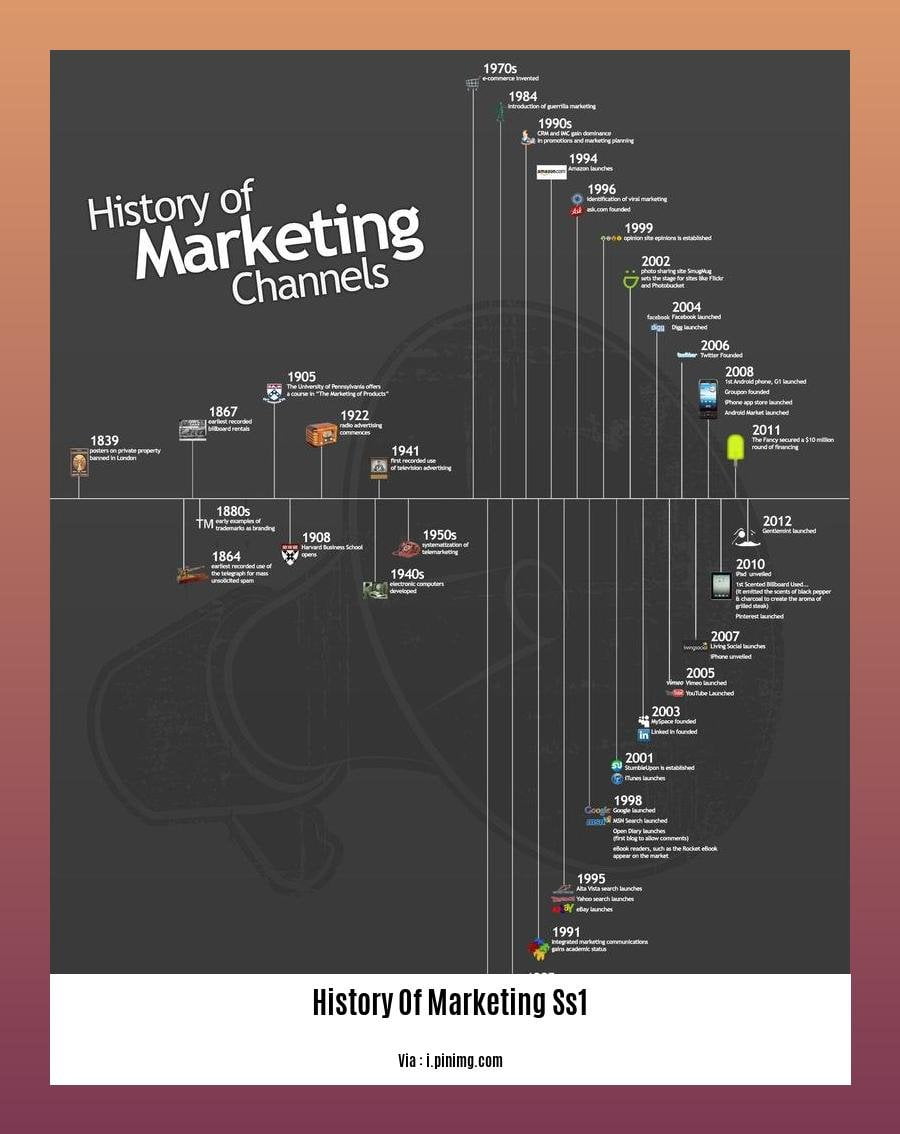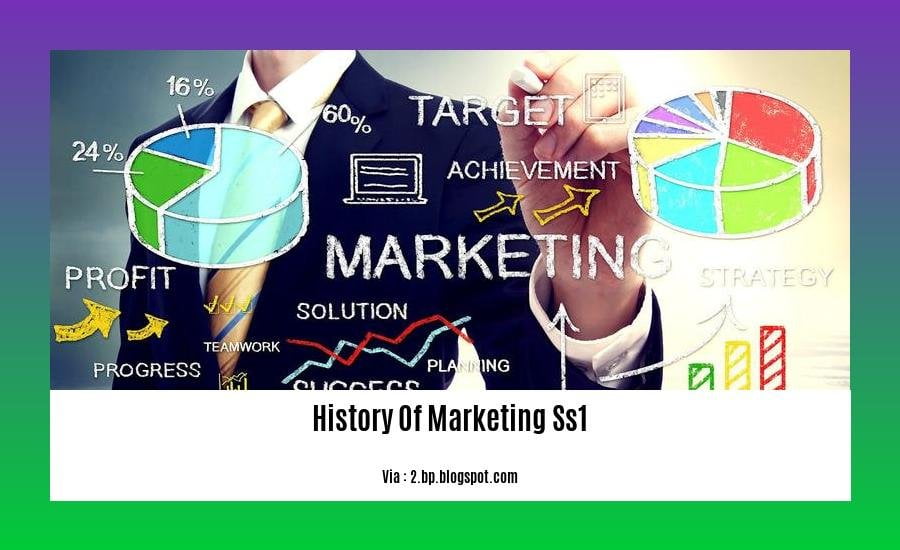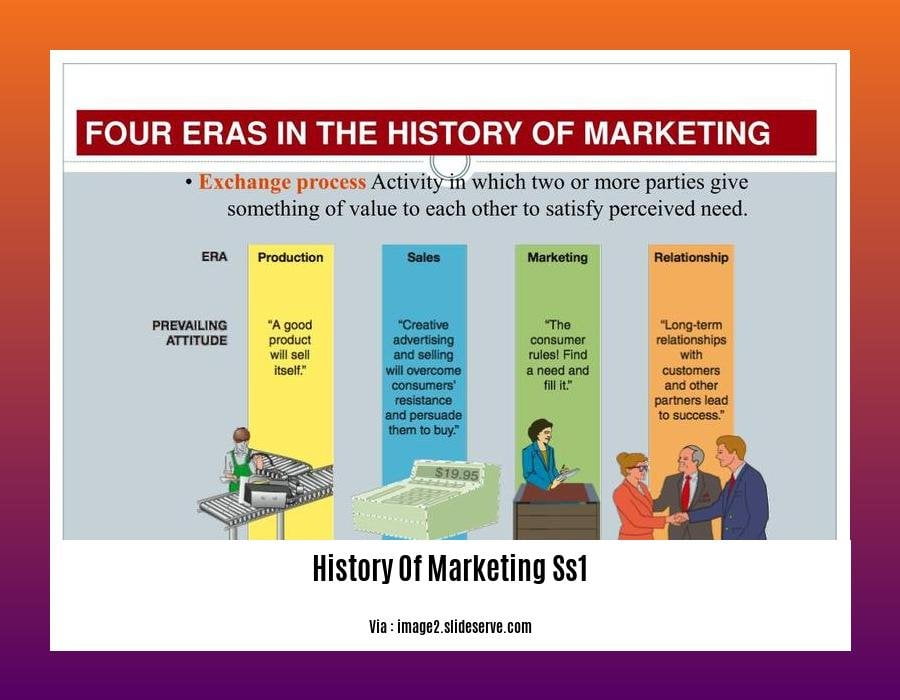Embark on a captivating journey through the annals of marketing in our article titled “A Journey Through Time: Unveiling the Rich History of Marketing ss1.” From the rudimentary practices of barter in ancient civilizations to the sophisticated digital strategies of today, we delve into the evolution of marketing, exploring how it has shaped businesses, influenced consumer behavior, and left an enduring impact on society.
Key Takeaways:
Marketing serves five core functions: maximizing consumption, consumer satisfaction, choice, life quality, and profit.
The history of marketing in Nigeria can be traced back to the colonial era, specifically from 100AD to 1860.
History of Marketing ss1

Imagine stepping into a time machine and embarking on a journey through the fascinating history of marketing. From its humble beginnings in ancient civilizations to its transformation into a sophisticated, data-driven discipline, marketing has played a pivotal role in shaping businesses and influencing consumer behavior.
1. The Genesis of Marketing: Barter and Beyond
The history of marketing ss1 traces its roots back to the primitive days of barter, when early humans exchanged goods and services to meet their needs. As societies evolved, so did the concept of marketing. In ancient civilizations like Mesopotamia, Egypt, and China, merchants utilized various techniques to promote their products, including public announcements, signage, and word-of-mouth.
2. The Middle Ages: The Rise of Trade Fairs and Guilds
During the Middle Ages, trade fairs and guilds emerged as important venues for marketing. These events allowed merchants to showcase their goods, establish connections with potential customers, and negotiate prices. Guilds, which were associations of artisans and merchants, played a crucial role in regulating trade and maintaining quality standards, thus fostering trust among consumers.
3. The Industrial Revolution: Mass Production and Advertising
The Industrial Revolution ushered in an era of mass production, leading to the need for effective marketing strategies to promote and sell goods. This period marked the rise of advertising, with businesses using newspapers, posters, and handbills to reach their target audience. Product differentiation became essential, as companies sought to stand out in an increasingly competitive marketplace.
4. The 20th Century: The Age of Consumerism and Globalization
The 20th century witnessed the emergence of consumerism, driven by rising disposable incomes and the proliferation of mass media. Marketing became more sophisticated, with companies employing market research, branding, and targeted advertising to influence consumer behavior. The globalization of markets led to the rise of multinational corporations, which leveraged their global reach to expand their customer base.
5. The Digital Revolution: The Era of Digital Marketing
The advent of the digital age revolutionized the marketing landscape. The rise of the internet, social media, and e-commerce platforms transformed the way businesses connect with their customers. Digital marketing techniques, such as search engine optimization (SEO), pay-per-click (PPC) advertising, social media marketing, and email marketing, became essential for businesses to reach and engage with their target audience.
Throughout history, marketing has evolved to meet the changing needs of businesses and consumers. From the early days of barter to the era of digital marketing, marketing has played a vital role in driving economic growth, fostering innovation, and shaping societal trends. As we look to the future, the history of marketing ss1 reminds us of the enduring power of this dynamic field and its ability to adapt to the ever-changing demands of the marketplace.
Discover the rich history of magazines in India, uncovering the significant contributions they have made to the country’s cultural and intellectual landscape. history of magazines in india
Delve into the captivating history of the maglalatik folk dance, tracing its origins, symbolism, and the unique rituals associated with this vibrant Philippine tradition. history of maglalatik folk dance
Explore the fascinating history of manicures, tracing the evolution of this beauty practice from ancient origins to modern-day trends, revealing the cultural and societal influences that have shaped its development. history of manicure
Unravel the intriguing history of manicures and pedicures, discovering how these beauty treatments have evolved over time, from their early origins to their current status as essential self-care rituals. history of manicure and pedicure
Industrial Revolution and Mass Marketing

The Industrial Revolution and the Transformation of Marketing
Before we dive into how the Industrial Revolution and Mass Marketing shaped marketing as we know it, take a step back in time with me and let me introduce you to the concept of marketing in its most primitive form.
What’s the earliest form of marketing? You ask. No, it’s not billboards or TV commercials. It’s good old-fashioned bartering. It basically means exchanging stuff you have for things you want without involving cold, hard cash. Think of it as the original form of networking.
Fast forward to the buzz of the Industrial Revolution. This was the game-changer. Mass production of goods required a new set of skills: marketing. With more stuff to sell, there was an urgent need to let people know about them.
And thus, advertising was born. Print ads, posters, and radio commercials became the go-to tools for getting their messages out. It was a time when brands shouted their messages to the masses, hoping to capture their attention.
The 20th century saw marketing evolve further. With the rise of consumerism and mass media, businesses had to up their game. It was no longer enough to just shout; they needed to persuade and create desire.
This era saw the birth of market research, brands, and targeted advertising. It was a time when brands started to understand their customers’ wants and needs and tailor their messages accordingly.
The Digital Revolution: A New Frontier
The digital revolution changed everything all over again. Welcome to the age of social media, email marketing, and online advertising. The internet created a whole new playing field for marketers. Suddenly, they could connect with their customers 24/7, right in their pockets.
And just like that, marketing was transformed yet again. This time, it’s all about personalization, creating experiences, and building relationships. It’s no longer about selling stuff but about connecting with people.
Key Takeaways:
- The Industrial Revolution laid the foundation for modern marketing, emphasizing mass production and advertising.
- The 20th century brought the concept of consumerism and mass media, leading to the rise of market research and branding.
- The digital revolution transformed marketing once more, emphasizing personalization and customer engagement.
References:
Digital Revolution and the Transformation of Marketing
The digital revolution has brought about a paradigm shift in the world of marketing, reshaping how businesses connect with their customers. Let’s journey through the evolution of marketing, from its humble origins to the high-tech era we live in today:
Ancient Origins
Marketing’s roots trace back to the dawn of civilization. In ancient marketplaces, merchants relied on word-of-mouth, vibrant signage, and public announcements to promote their wares.
Industrial Revolution
The Industrial Revolution ushered in mass production, necessitating new approaches to marketing. Advertising emerged, utilizing print, posters, and handbills to reach the burgeoning consumer base.
Mid-20th Century
The post-war era saw the rise of television and consumerism. Mass media enabled brands to reach vast audiences, leading to iconic ad campaigns and the golden age of advertising.
The Digital Revolution
The internet’s advent marked a pivotal moment in marketing history. Websites, email marketing, and search engines transformed the way businesses communicated with customers.
Social Media and Beyond
The 21st century brought the rise of social media, revolutionizing marketing once again. Platforms like Facebook, Twitter, and Instagram provided businesses with unprecedented access to their target audience.
Key Takeaways:
The digital revolution has transformed marketing, shifting it from mass campaigns to targeted, personalized messaging.
Digital marketing techniques like SEO, PPC, social media, and email marketing have become essential for businesses of all sizes.
The focus has shifted from traditional advertising to building authentic customer relationships and earning trust.
Marketing has become more data-driven, enabling businesses to track customer behavior and tailor their strategies accordingly.
Conclusion:
The digital revolution has redefined the marketing landscape, empowering businesses to connect with their customers in innovative and personalized ways. As technology continues to evolve, marketers must adapt and embrace new opportunities to stay ahead in this ever-changing field.
References
- The History and Evolution of Digital Marketing
- The Evolution of Marketing: From Cave Drawings to Social Media
The Future of Marketing: AI, Personalization, and Sustainability
The marketing landscape is undergoing a profound transformation driven by the rapid ascendancy of artificial intelligence (AI), personalization, and sustainability. These intertwined forces are redefining the way businesses connect with consumers, creating a future of marketing that is both exciting and uncharted.
AI: The Power of Predictive Personalization
AI is revolutionizing marketing by enabling businesses to harness the power of data to understand and predict customer behavior. From tailored product recommendations to personalized marketing messages, AI is transforming the way companies engage with their customers.
The Personalization Imperative
In the age of the empowered consumer, personalization is no longer an option but a necessity. Customers expect brands to understand their individual needs and preferences and deliver experiences that are tailored to their unique journeys. AI-driven personalization is the key to unlocking this level of customer intimacy.
Sustainability: The Future-Proof Strategy
Sustainability is emerging as a defining force in marketing, as consumers increasingly seek out brands that align with their values and demonstrate a commitment to environmental responsibility. From eco-friendly packaging to carbon-neutral supply chains, sustainability is becoming a key differentiator for businesses looking to thrive in the future.
Navigating the Future of Marketing
As we navigate the evolving landscape of marketing, it’s essential for businesses to embrace these transformative trends and adapt their strategies accordingly. Here’s a roadmap for success:
1. Invest in AI and Data Analytics: Harness the power of AI to collect, analyze, and interpret customer data, enabling you to deliver personalized experiences and make data-driven decisions.
2. Personalize Every Touchpoint: From email marketing to social media engagement, ensure that every customer interaction is tailored to their individual preferences and needs.
3. Prioritize Sustainability: Integrate sustainability into your marketing strategy, showcasing your commitment to environmental responsibility and attracting eco-conscious consumers.
Key Takeaways:
AI is revolutionizing marketing by enabling personalized experiences and predictive analytics.
Personalization is essential for building customer intimacy and loyalty.
Sustainability is a key differentiator for businesses looking to thrive in the future.
Investing in AI, data analytics, and personalization is crucial for success.
Prioritizing sustainability demonstrates your commitment to environmental responsibility and attracts eco-conscious consumers.
Sources:
[1]
[2]
FAQ
Q1: What are the key functions of a marketing system?
A1: The primary functions of a marketing system include maximizing consumption, consumer satisfaction, choice, quality of life, and profit.
Q2: How did marketing evolve during the Industrial Revolution?
A2: During the Industrial Revolution, mass production led to the need for new ways to promote and sell goods, resulting in the emergence of marketing as a discipline.
Q3: What are some traditional marketing techniques used in the early days?
A3: In the early days of marketing, companies relied on impersonal, broad campaigns such as print ads, TV commercials, and billboards to reach consumers.
Q4: Which brands played a significant role in shaping modern marketing?
A4: Brands like Kellogg’s, Coca-Cola, and Apple were pioneers in using mass advertising, branding, and celebrity endorsements, which transformed the marketing landscape.
Q5: How has digital marketing changed the way businesses market their products and services?
A5: The digital marketing era has shifted the focus from traditional advertising to building relationships with customers through social media, email marketing, and search engine optimization (SEO).
- Georgia Platform: A Southern Strategy, 1850s - March 31, 2025
- How many weeks is 40 days: Quick Conversion Guide for Accurate Results - March 31, 2025
- How many feet is 300 meters? 984 Feet: Understand Length Conversions Easily - March 31, 2025
















